

#DThink Twitter Chat Recap: How Internal Communication Impacts Employee Engagement. Why your approach to employee engagement may be wrong. It’s no mystery that employee engagement is low.
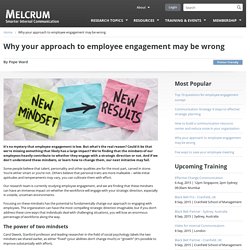
But what’s the real reason? Could it be that we’re missing something that likely has a large impact? We’re finding that the mindsets of our employees heavily contribute to whether they engage with a strategic direction or not. And if we don’t understand these mindsets, or learn how to change them, our next initiative may fail. Some people believe that talent, personality and other qualities are for the most part, carved in stone. 2014 Trends in Global Employee Engagement. How prepared are you, your company and your talent to drive performance in the face of impending change?

Business leaders today face unprecedented challenges brought on by simultaneous macro-level economic, technological, demographic and social trends. Many leaders will need to revisit and set new organizational strategies, but they cannot effectively execute on what is required for growth without engaging their talent in the right behaviors for the future. Making engagement happen will be the business challenge of the next decade and a focal point of the emerging talent imperative. Real employee engagement means that employees are maximizing their value to the organization. Is Employee Engagement important to managers? Research shows employee engagement relies on purpose. Employee engagement has become a labyrinth for internal communications teams to navigate as loyalty wanes and companies expand.
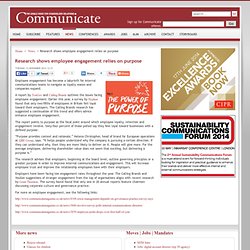
A report by YouGov and Calling Brands outlines the issues facing employee engagement. Internal marketing for engaging employees on the corporate responsibility journey. Employee Engagement Over The Summer. Theblueballroom knows your organisation can present you with numerous challenges: new strategies, mergers, acquisitions and restructuring.
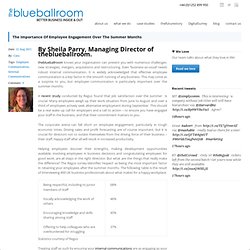
Even ‘business-as-usual’ needs robust internal communication. It is widely acknowledged that effective employee communication is a key factor in the smooth running of any business. This may come as a surprise to you, but employee communication is particularly important over the summer months. A recent study conducted by Regus found that job satisfaction over the summer is crucial.
Many employees weigh up their work situation from June to August and over a third of employees actively seek alternative employment during September. The corporate arena can fall short on employee engagement, particularly in tough economic times. Three Things You Need to Know about the State of Employee Engagement. Last Updated Oct 29, 2011 4:04 PM EDT.
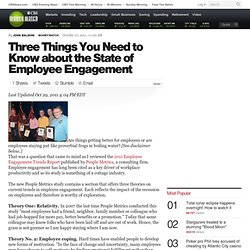
Why are Workers Satisfied but Disengaged? Employees were generally satisfied with their jobs in 2011, yet they remain only moderately engaged, research indicates.
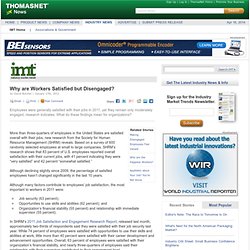
What do these findings mean for organizations? More than three-quarters of employees in the United States are satisfied overall with their jobs, new research from the Society for Human Resource Management (SHRM) reveals. Based on a survey of 600 randomly selected employees at small to large companies, SHRM’s research shows that 83 percent of U.S. employees reported overall satisfaction with their current jobs, with 41 percent indicating they were “very satisfied” and 42 percent “somewhat satisfied.”
Although declining slightly since 2009, the percentage of satisfied employees hasn’t changed significantly in the last 10 years. 2012 Workplace Trends Report: Integration, Flexibility and Wellness Top Drivers of Employee Engagement. GAITHERSBURG, Md., Jan. 18, 2012 /PRNewswire/ -- Sodexo, Quality of Daily Life Solutions provider to more than 1,800 corporate clients in the United States, released its 2012 Workplace Trends Report today, offering a unique perspective on the workplace that combines insight from clients, academia, principal research, and leading facilities management and human resource trade organizations.
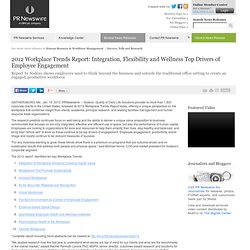
The research predicts continued focus on well-being and the ability to deliver a unique value proposition to business communities that focuses on not only integrated, effective and efficient use of space, but also the performance of human capital. Employees are looking to organizations for tools and resources to help them simplify their lives, stay healthy and balanced, and bring their "whole self" to work as these continue to be top drivers of engagement. Employee engagement, productivity, brand image and loyalty continue to be relevant measures of success. Engagement – it’s a "no brainer"! - Chief Executive Officer. Chris Roebuck explains how highly engaged employees deliver a more effective performance and a better bottom line – at no extra cost to your organisation.

Sometimes I am concerned by the lack of knowledge among the CEO and top leadership community regarding the compelling case for building employee engagement. As soon as one finance director had seen the evidence he exclaimed, "This is a total no-brainer – we should have been doing this for years! " This also underpins the case for developing good leadership: good leadership builds engagement that delivers a better bottom line – it's that simple. This article is designed to help senior corporate leaders understand the potential benefit that better engagement driven by good leadership can bring to their organisation.
It sets out some simple, effective and low-cost ways in which organisations can rapidly engage staff more effectively and get extra performance from those staff. Employee engagement in UK businesses lags behind the global trend, according to ORC International. HR Editorial , 10 Oct 2011 The overall picture of employee engagement in the UK is lagging in 2011,according to the global Perspectives survey.

The employee survey from ORC International, published on Friday found the UK fell four places in the global engagement rankings to 17th. The UK job market has suffered extensively as a result of the financial crisis. Among other influences, the £95 billion government spending cuts have resulted in job losses, mass change and a continued outlook of uncertainly for the UK workforce. The Costs of Disengagement. 25% of employees are bored most of the time. Research by the University of Central Lancashire has revealed that 1 out of 4 office workers suffer from "chronic boredom" and rely on coffee, chocolate and alcohol for stimulation.
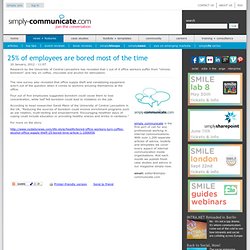
The new survey also revealed that office supply theft and vandalizing equipment aren't out of the question when it comes to workers amusing themselves at the office. Four out of five employees suggested boredom could cause them to lose concentration, while half felt boredom could lead to mistakes on the job. 3 People Intelligence Trends for New Tech. We recently launched the first annual ‘New Tech’ Employee Engagement Benchmark report. So far, we’ve had great feedback from our customers and the broader ‘People Ops’ community. One thing that’s clear across the board is ‘New Tech’ companies put a great emphasis on their culture. Culture is seen at the core of their competitive advantage. 2013 'New Tech' Employee Engagement Benchmark. What is the culture like at some of the fastest growing, most ambitious companies in the world?
And how does that differ from what you see at other companies? They are growing like crazy, have visions that are mind boggling in their reach and are some of the hottest companies in the world to work at. Welcome to the 'New Tech'. What makes you a 'New Tech' company is not what “industry” you're in–it's how you approach it. Maybe retail, publishing, entertainment, education, internet services or software but at heart they are Internet, and by extension, technology companies.